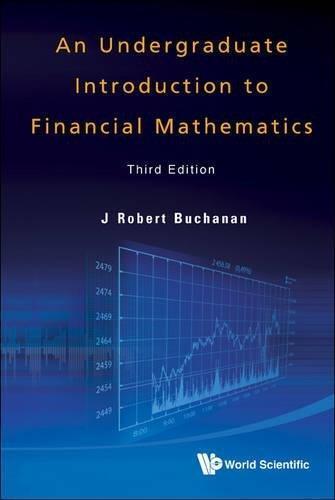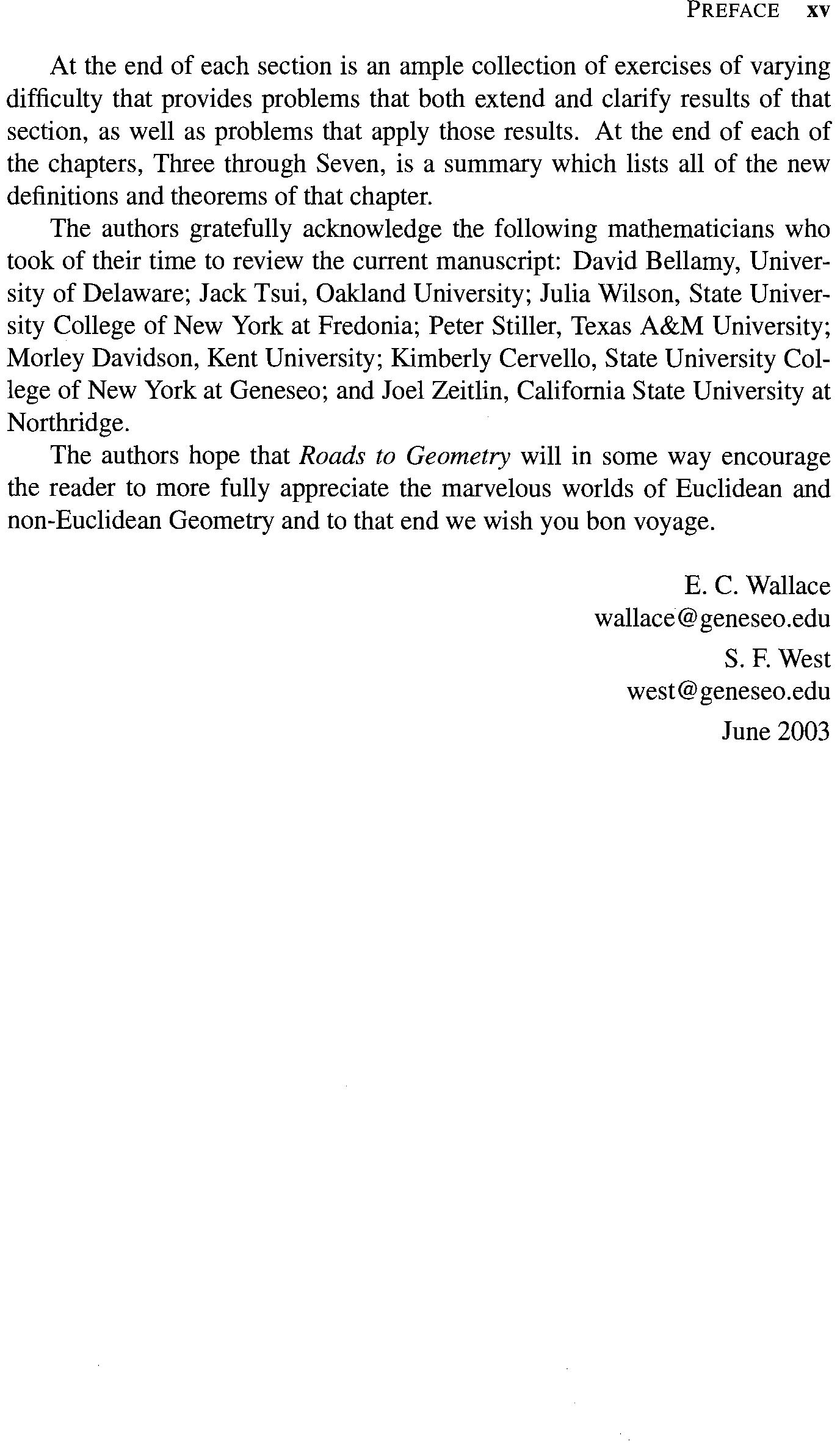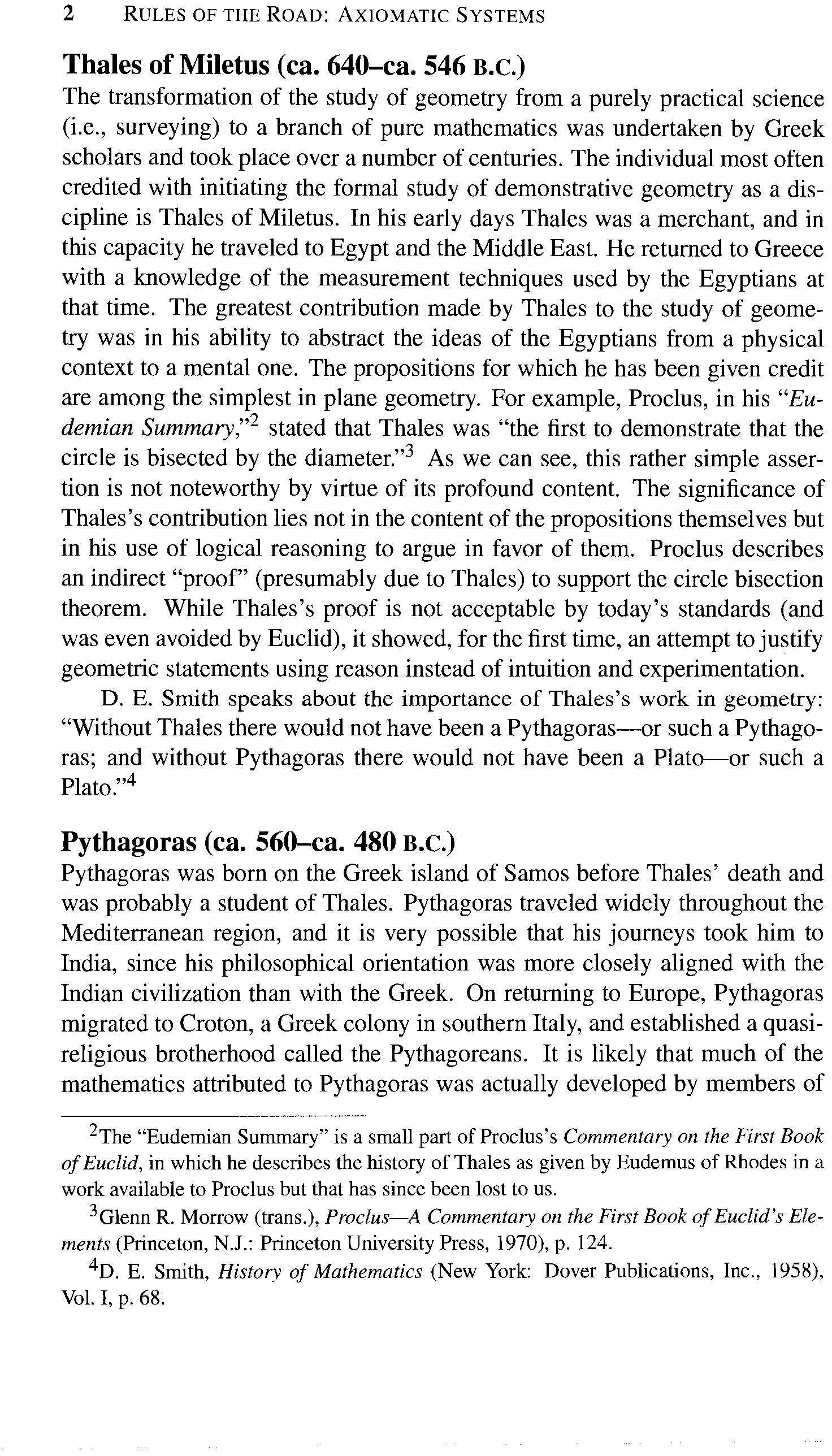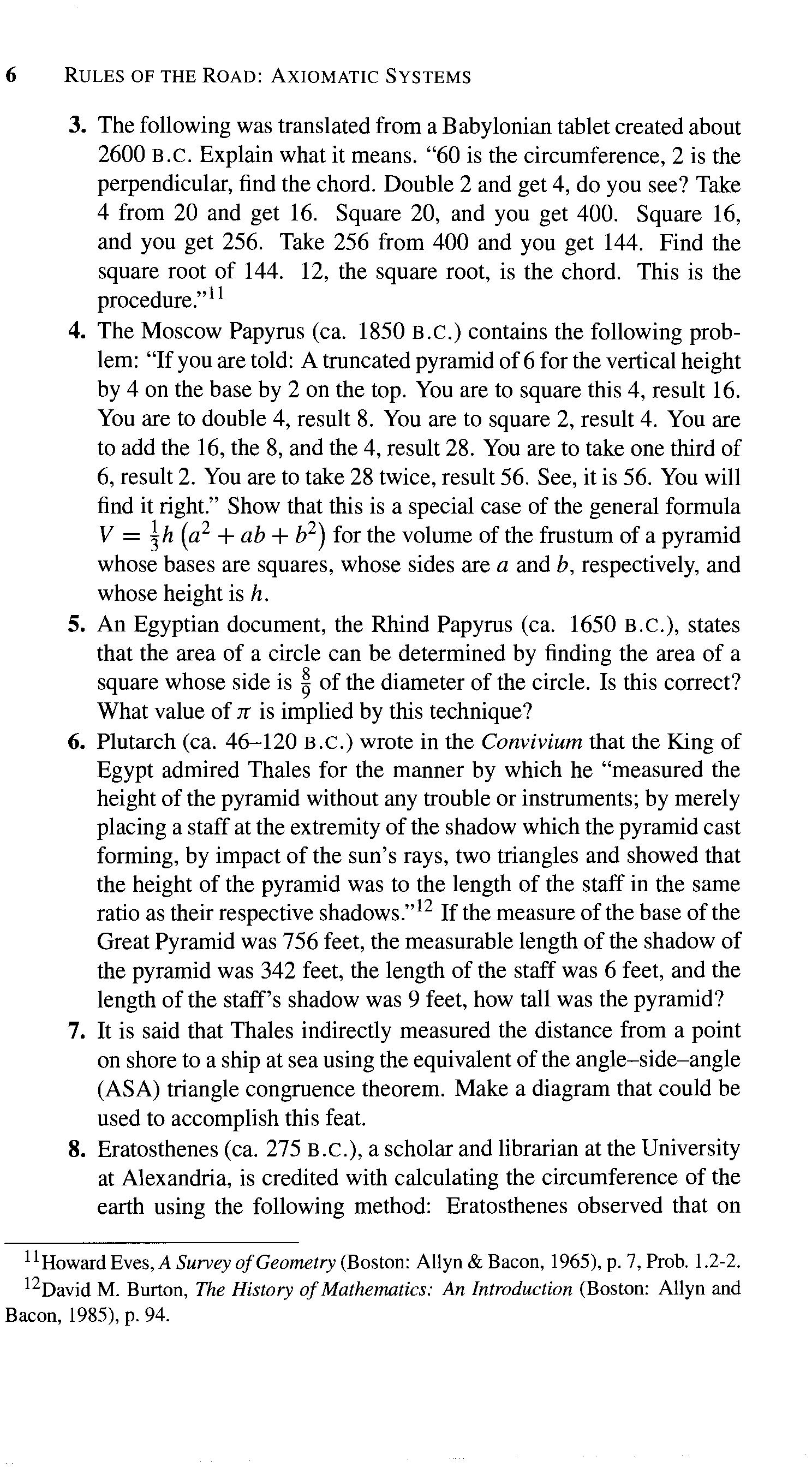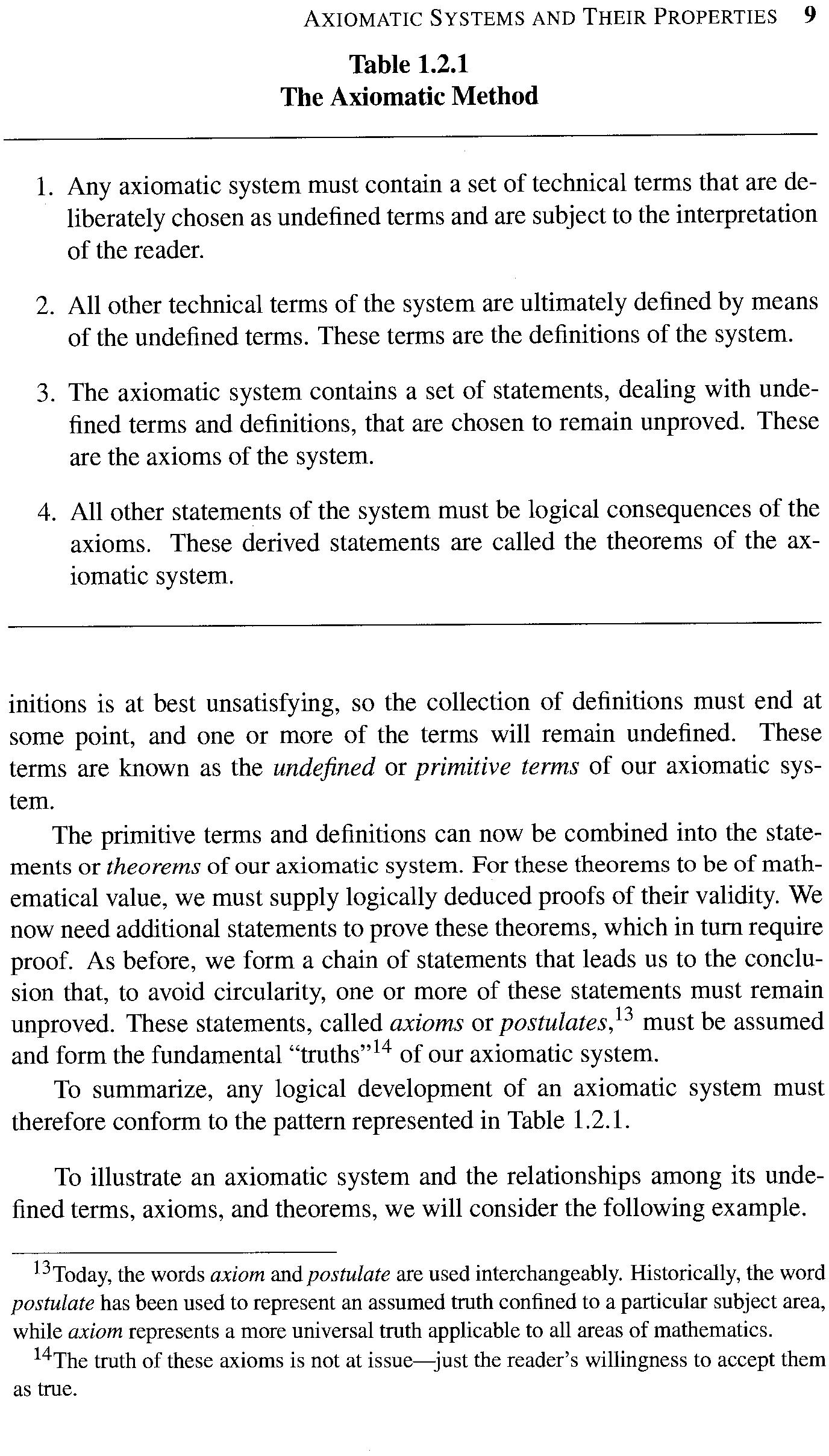https://ebookmass.com/product/roads-to-geometry-third-
Instant digital products (PDF, ePub, MOBI) ready for you
Download now and discover formats that fit your needs...
Coordinate Geometry for JEE (Advanced), 3rd edition G. Tewani
https://ebookmass.com/product/coordinate-geometry-for-jeeadvanced-3rd-edition-g-tewani/
ebookmass.com
Undergraduate Introduction to Financial Mathematics, an (Third Edition ) 3rd
https://ebookmass.com/product/undergraduate-introduction-to-financialmathematics-an-third-edition-3rd/
ebookmass.com
All Roads Lead to You Jackie Ashenden
https://ebookmass.com/product/all-roads-lead-to-you-jackie-ashenden-3/ ebookmass.com
His Convenient Match (Lost Fortunes, Found Love Book 6) Rose Pearson
https://ebookmass.com/product/his-convenient-match-lost-fortunesfound-love-book-6-rose-pearson/
ebookmass.com
ROADS to GEOMETRY
Third Edition
Edward C. Wallace
Stephen F. West
Preface
1 Rules of the Road: Axiomatic Systems
1.1 Historical Background . . . . . . . . . . Thales of Miletus (ca. 640-ca. 546 B.C.)
Pythagoras (ca. 560-ca. 480 B.C.) .... Hippocrates of Chios (ca. 46O-ca. 380 B.C.)
Plato (ca. 427-<:a. 348 B.C.) ...
Eudoxus (ca. 400-<:a. 347 B.C.)
Euclid (ca. 330-ca. 270 B.C.) ..
Exercises 1.1
1.2 Axiomatic Systems and Their Properties. The Axiomatic Method. Models
Properties of Axiomatic Systems. Exercises 1.2
1.3 Finite Geometries.
Four-Point Geometry ...... . The Geometries of Fano and Young Exercises 1.3
1.4 Axioms for Incidence Geometry Exercises 1.4
2 Many Ways to Go: Axiom Sets for Geometry
2.1 Introduction................
2.2 Euclid's Geometry and Euclid's Elements Exercises 2.2
2.3 Modern Euclidean Geometries
Exercises 2.3
2.4 Hilbert's Axioms for Euclidean Geometry Exercises 2.4
7.5
At the end of each section is an ample collection of exercises of varying difficulty that provides problems that both extend and clarify results of that section, as well as problems that apply those results. At the end of each of the chapters, Three through Seven, is a summary which lists all of the new definitions and theorems of that chapter.
The authors gratefully acknowledge the following mathematicians who took of their time to review the current manuscript: David Bellamy, University of Delaware; Jack Tsui, Oakland University; Julia Wilson, State University College of New York at Fredonia; Peter Stiller, Texas A&M University; Morley Davidson, Kent University; Kimberly Cervello, State University College of New York at Geneseo; and Joel Zeitlin, California State University at Northridge.
The authors hope that Roads to Geometry will in some way encourage the reader to more fully appreciate the marvelous worlds of Euclidean and non-Euclidean Geometry and to that end we wish you bon voyage.
E. C. Wallace wallace@geneseo.edu
S. F. West west@geneseo.edu
June 2003
Thales of Miletus (ca. 64O-ca. 546 B.C.)
The transformation of the study of geometry from a purely practical science (i.e., surveying) to a branch of pure mathematics was undertaken by Greek scholars and took place over a number of centuries. The individual most often credited with initiating the formal study of demonstrative geometry as a discipline is Thales of Miletus. In his early days Thales was a merchant, and in this capacity he traveled to Egypt and the Middle East. He returned to Greece with a knowledge of the measurement techniques used by the Egyptians at that time. The greatest contribution made by Thales to the study of geometry was in his ability to abstract the ideas of the Egyptians from a physical context to a mental one. The propositions for which he has been given credit are among the simplest in plane geometry. For example, Proclus, in his "Eudemian Summary,,,2 stated that Thales was "the first to demonstrate that the circle is bisected by the diameter."3 As we can see, this rather simple assertion is not noteworthy by virtue of its profound content. The significance of Thales's contribution lies not in the content of the propositions themselves but in his use of logical reasoning to argue in favor of them. Proclus describes an indirect "proof" (presumably due to Thales) to support the circle bisection theorem. While Thales's proof is not acceptable by today's standards (and was even avoided by Euclid), it showed, for the first time, an attempt to justify geometric statements using reason instead of intuition and experimentation. D. E. Smith speaks about the importance of Thales's work in geometry: "Without Thales there would not have been a Pythagoras-or such a Pythagoras; and without Pythagoras there would not have been a Plato--or such a Plato.,,4
Pythagoras (ca. 56O-ca. 480 B.C.)
Pythagoras was born on the Greek island of Samos before Thales' death and was probably a student of Thales. Pythagoras traveled widely throughout the Mediterranean region, and it is very possible that his journeys took him to India, since his philosophical orientation was more closely aligned with the Indian civilization than with the Greek. On returning to Europe, Pythagoras migrated to Croton, a Greek colony in southern Italy, and established a quasireligious brotherhood called the Pythagoreans. It is likely that much of the mathematics attributed to Pythagoras was actually developed by members of
2The "Eudemian Summary" is a small part ofProcius's Commentary on the First Book of Euclid, in which he describes the history of Thales as given by Eudemus of Rhodes in a work available to Proclus but that has since been lost to us.
3 Glenn R. Morrow (trans.). Proclus-A Commentary on the First Book of Euclid's Elements (Princeton, N.J.: Princeton University Press, 1970), p. 124.
4D E. Smith, History of Mathematics (New York: Dover Publications, Inc., 1958), VoL I, p. 68.
this brotherhood during the 200 or so years of its existence. One disappointment lies in the fact that, whereas Pythagoras probably stated the theorem that bears his name, it is equally probable that he could not prove it. The Pythagoreans took mathematical thought a step beyond the point to which Thales had brought it. Whereas Thales had formalized a portion of the geometry that he encountered, the Pythagorean philosophy was to develop mathematical results exclusively as the result of deduction. Following his death, Pythagoras's followers split into two factions; the akousmatikoi, who accepted the words of the "master" as revelation, and the mathematikoi, who pursued new learning (mathesis) and helped to transform mathematics into a deductive science. s It was during this time that "chains of propositions were developed in which each successive proposition was derived from earlier ones.,,6 The Pythagorean school set the tone for all the Greek mathematics that was to follow, and since the ideas of Plato were largely committed to mathematics, we could say that Pythagoras had a major effect on all of Greek philosophy.
Hippocrates of Chios (ca. 460-ca. 380 B.C.)
Hippocrates was born on the Greek island of Chi os. Chios is a small island close to Samos, the birthplace of Pythagoras. For this reason, it is highly probable that Hippocrates may have come under the influence of the Pythagoreans. Hippocrates spent most of his later adult life in Athens, where he became proficient in geometry. While teaching geometry, he was credited with preparing a textbook entitled the Elements of Geometry, in which he arranged theorems in a logical sequence so that later ones could be proved on the basis of earlier ones. This lost textbook foreshadowed Euclid's Elements.
Plato (ca. 427-ca. 348 B.C.)
Plato was born to an aristocratic family in Athens. The early part of his life coincides with the era of the Peloponnesian Wars, during which time he served in the Athenian cavalry. In his early twenties, he met Socrates, who had a profound effect on his education. Plato's role in the development of geometry (and of mathematics) is often overshadowed by his preeminent status in Greek philosophy in general. In approximately 388 B.C., he established the Academy, which attracted the most famous scholars of the time. Inscribed above the gate to the Academy was the motto "Let no man ignorant of geometry enter." The study of mathematics at the Academy was confined to pure mathematics, with the emphasis placed on soundness of reason. Plato's contributions to theoretical mathematics, in addition to adding geometry to higher education, included references to the necessity of framing sound definitions, to
5Ronald Calinger (ed.), Classics of Mathematics (Upper Saddle River, N.J.: Prentice Hall, 1995), p. 50.
6Eves, Historical Topics, p. 172.
RULES OF THE ROAD: AXIOMATIC SYSTEMS
3. The following was translated from a Babylonian tablet created about 2600 B.C. Explain what it means. "60 is the circumference, 2 is the perpendicular, find the chord. Double 2 and get 4, do you see? Take 4 from 20 and get 16. Square 20, and you get 400. Square 16, and you get 256. Take 256 from 400 and you get 144. Find the square root of 144. 12, the square root, is the chord. This is the procedure." 11
4. The Moscow Papyrus (ca. 1850 B.C.) contains the following problem: "If you are told: A truncated pyramid of 6 for the vertical height by 4 on the base by 2 on the top. You are to square this 4, result 16. You are to double 4, result 8. You are to square 2, result 4. You are to add the 16, the 8, and the 4, result 28. You are to take one third of 6, result 2. You are to take 28 twice, result 56. See, it is 56. You will find it right." Show that this is a special case of the general formula V 1h (a 2 + ab + b 2 ) for the volume of the frustum of a pyramid whose bases are squares, whose sides are a and b, respectively, and whose height is h.
5. An Egyptian document, the Rhind Papyrus (ca. 1650 B.C.), states that the area of a circle can be determined by finding the area of a square whose side is of the diameter of the circle. Is this correct? What value of JT is implied by this technique?
6. Plutarch (ca. 46-120 B.C.) wrote in the Convivium that the King of Egypt admired Thales for the manner by which he "measured the height of the pyramid without any trouble or instruments; by merely placing a staff at the extremity of the shadow which the pyramid cast forming, by impact of the sun's rays, two triangles and showed that the height of the pyramid was to the length of the staff in the same ratio as their respective shadows." 12 If the measure of the base of the Great Pyramid was 756 feet, the measurable length of the shadow of the pyramid was 342 feet, the length of the staff was 6 feet, and the length of the staff's shadow was 9 feet, how tall was the pyramid?
7. It is said that Thales indirectly measured the distance from a point on shore to a ship at sea using the equivalent of the angle-side-angle (AS A) triangle congruence theorem. Make a diagram that could be used to accomplish this feat.
8. Eratosthenes (ca. 275 B.C.), a scholar and librarian at the University at Alexandria, is credited with calculating the circumference of the earth using the following method: Eratosthenes observed that on
11 Howard Eves, A Survey of Geometry (Boston: Allyn & Bacon, 1965), p. 7, Prob. 1.2-2. 12David M. Burton, The History of Mathematics: An Introduction (Boston: Allyn and Bacon, 1985), p. 94.
Table 1.2.1
The Axiomatic Method
1. Any axiomatic system must contain a set of technical terms that are deliberately chosen as undefined terms and are subject to the interpretation of the reader.
2. All other technical terms of the system are ultimately defined by means of the undefined terms. These terms are the definitions of the system.
3. The axiomatic system contains a set of statements, dealing with undefined terms and definitions, that are chosen to remain unproved. These are the axioms of the system.
4. All other statements of the system must be logical consequences of the axioms. These derived statements are called the theorems of the axiomatic system.
initions is at best unsatisfying, so the collection of definitions must end at some point, and one or more of the terms will remain undefined. These terms are known as the undefined or primitive terms of our axiomatic system.
The primitive terms and definitions can now be combined into the statements or theorems of our axiomatic system. For these theorems to be of mathematical value, we must supply logically deduced proofs of their validity. We now need additional statements to prove these theorems, which in tum require proof. As before, we form a chain of statements that leads us to the conclusion that, to avoid circularity, one or more of these statements must remain unproved. These statements, called axioms or postulates, 13 must be assumed and form the fundamental "truths,,14 of our axiomatic system.
To summarize, any logical development of an axiomatic system must therefore conform to the pattern represented in Table 1.2.1.
To illustrate an axiomatic system and the relationships among its undefined terms, axioms, and theorems, we will consider the following example.
13Today, the words axiom and postulate are used interchangeably. Historically, the word postulate has been used to represcnt an assumed truth confined to a particular subject arca, while axiom represents a more universal truth applicable to all arc as of mathcmatics.
14Thc truth of these axioms is not at issue-just the reader's willingness to accept them as true.
Finance
People: Bob, Ted, and Carol. Committees: Entertainment, Finance, and Refreshments.
1.2.1
1.2.2
Figure
Figure
AXIOMATIC SYSTEMS AND THEIR PROPERTIES
you in the Exercises) become correct statements under the interpretation in Example 1.2.2. For example, Fe-Fo Theorem I now reads as follows: Each committee contains exactly two people. However, in the interpretation found in Example 1.2.3, the theorems need not be correct statements since the axioms are not satisfied.
Models play an important role in the study of axiomatic systems. Suppose that in our system we have a statement for which we are unsure of the existence of a proof (i.e., we don't know whether the statement is a theorem or not). By investigating models we can gain insight into the correctness of the statement. In particular, if one model exists in which the statement is incorrect, we can be assured that no proof of the statement exists. The reader is cautioned, however, that the reverse is not always true. Simply because a statement is correct in one model does not ensure its correctness in all models, and thus it may not be a theorem in the axiomatic system. It is always a good practice to create several different models when investigating axiomatic systems.
When creating models, it is possible to produce two seemingly different models that, on closer inspection, are essentially the same. By "essentially the same" we mean that there exists a one-to-one correspondence between the interpretation of each set of undefined terms such that any relationship between the undefined terms in one model is preserved, under that one-to-one correspondence, in the second model. Two models that are essentially the same are said to be isomorphic, and the one-to-one correspondence is called an isomorphism.
Example 1.2.4
Consider the axiomatic system in Example 1.2.1 where Fe's are interpreted as the seaports of Hyannisport on Cape Cod, Oak Bluffs on Martha's Vineyard, and Nantucket on Nantucket Island, and Fo's are interpreted as the ferry routes (see Fig. 1.2.3). This model is isomorphic to the model in Example 1.2.2.
Example 1.2.5
Let the Fe's of our axiomatic system be interpreted as the letters in the set S = {P, Q, R}, and let the Fo's be interpreted as all the two-element subsets of S. This model is isomorphic to the model in Example 1.2.2 under the oneto-one correspondence:
P +'T Bob
Q +'T Ted
R +'T Carol Entertainment Committee +'T Refreshments Committee {P, Q} +'T {P, R] {Q, R] +'T Finance Committee
This model is also isomorphic to the model in Example 1.2.4. Why?
To illustrate the fact that every one-to-one correspondence between two different interpretations of the undefined terms of some axiomatic system is



